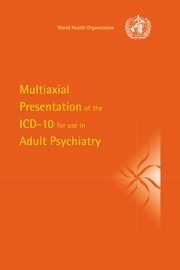Book contents
- Frontmatter
- Contents
- PART I
- Introduction
- Acknowledgements
- Development of the ICD-10 multiaxial system
- Structure of the ICD-10 multiaxial system
- The ICD-10 Multiaxial Diagnostic Formulation Form and its use
- Field trials of the ICD-10 multiaxial system
- Comment
- PART II
- Index
- The ICD-10 Multiaxial Diagnostic Formulation Form
Development of the ICD-10 multiaxial system
from PART I
Published online by Cambridge University Press: 04 August 2010
- Frontmatter
- Contents
- PART I
- Introduction
- Acknowledgements
- Development of the ICD-10 multiaxial system
- Structure of the ICD-10 multiaxial system
- The ICD-10 Multiaxial Diagnostic Formulation Form and its use
- Field trials of the ICD-10 multiaxial system
- Comment
- PART II
- Index
- The ICD-10 Multiaxial Diagnostic Formulation Form
Summary
The first multiaxial system developed under WHO auspices was a multiaxial classification of mental disorders in childhood. This classification, originally produced as a companion to the ICD-8, currently uses ICD-10 diagnoses and places them in the following multiaxial framework: Axis I – Clinical psychiatric syndromes; Axis II – Specific disorders of psychological development; Axis III – Intellectual level; Axis IV – Medical conditions; Axis V – Associated abnormal psychosocial situations; and Axis VI – Global assessment of psychosocial disability.
Another multiaxial system produced and tested in the framework of a WHO study in primary care settings is a triaxial classification of problems frequently presenting in primary health care. The system was developed to facilitate and stimulate the recording of psychosocial problems in primary health care and requires that general practitioners record for each patient: (a) psychological problem(s); (b) social problem(s); (c) physical problem(s). The fact that the system was not linked to the main body of the ICD–10 made its use sporadic and less attractive.
Since a WHO meeting on the diagnosis and classification of mental disorders held in Moscow in 1969, there has been a number of recommendations regarding the development of a multiaxial classification of mental disorders in old age. The axes were to serve for the recording of the clinical psychiatric syndrome, of the type of (cognitive) impairment and of the severity of the patient's condition in general (i.e., dependence on others for survival).
- Type
- Chapter
- Information
- Publisher: Cambridge University PressPrint publication year: 1997



